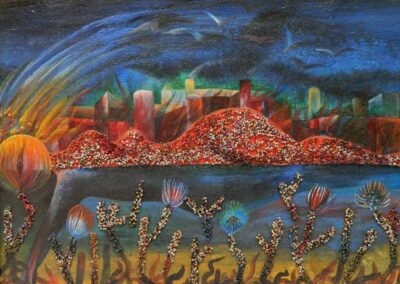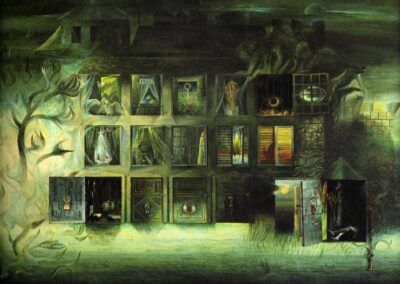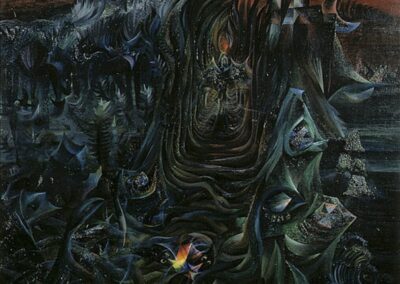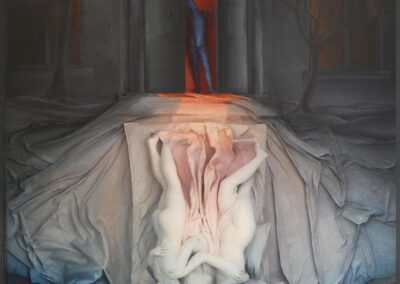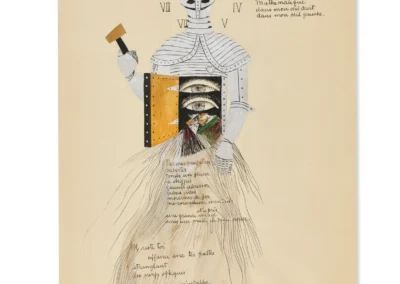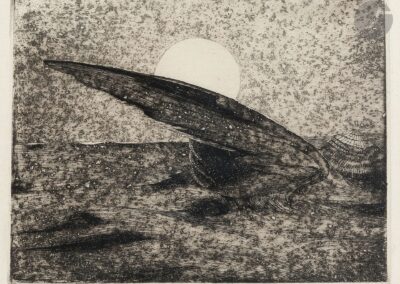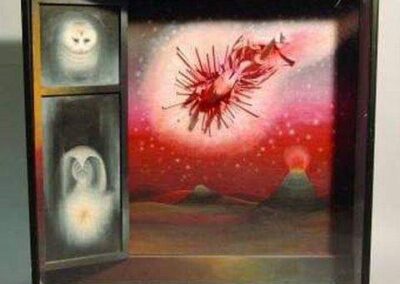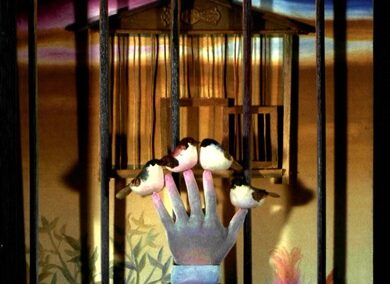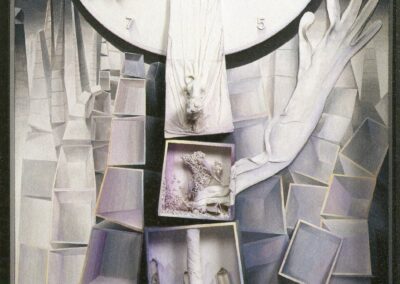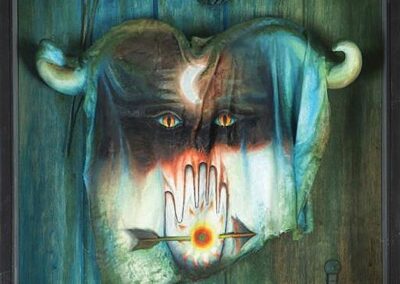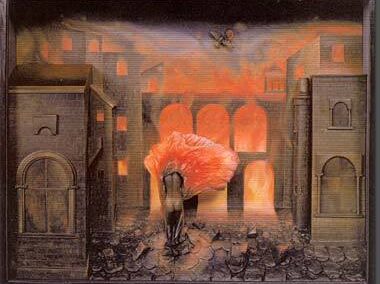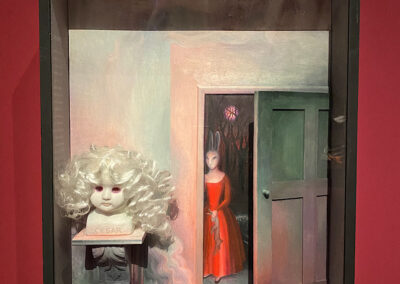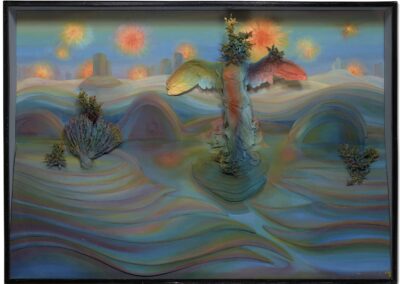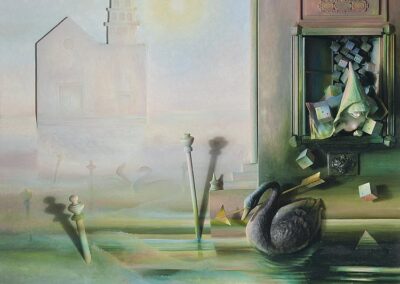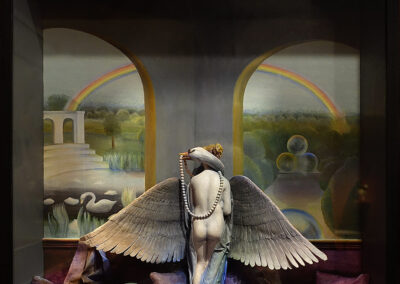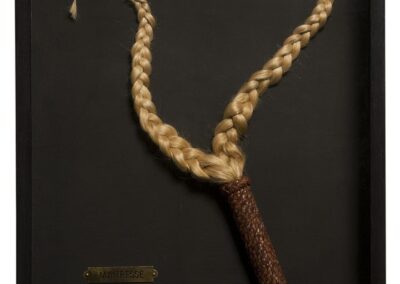Our next Artist You Need To Know is Mimi Parent (1924 – 2005).
Parent was a Canadian artist who spent the majority of her life and career in Paris, France : she officially became a member of the Surrealist group of artists in 1959, exhibiting frequently with them but also was a mainstay of the group in an organizational capacity. She is perhaps best known for her 3D tableaux boxes : these mixed media works incorporated symbols and elements from folklore, mythology and the subconscious. Lunar and solar metaphors – as representations of masculinity and femininity – were also common in Parent’s artwork. Faith and eroticism also defined her work, as a response to her early religious ‘education.’
From the accompanying text to the exhibition Surrealism in the Feminine at the Montmartre Museum (2023) : “Mimi Parent is one of the most untimely artists of surrealist creation. Her work is immediately marked by impropriety. Its singularity lies in the diversity of materials and techniques she uses: collage, engraving, painting, objects with fetishistic significance and embroidery.”
Mimi Parent was born Montréal : she was the eighth architect Lucien Parent’s nine children. Parent was a pupil of Alfred Pellan (a previously featured Artist You Need To Know) at the École des Beaux-Arts in Montréal (1942 to 1947): Pellan was a significant influence on the young artist and Parent (with Pellan and several other young artists) founded the anti conformist group Prisme d’yeux in 1948. She was expelled from art school for this (and other ‘rebellious’ and ‘avant garde’ actions). Parent’s successful exhibition at the Dominion Gallery in Montréal did little to assuage her frustration at the state of contemporary art in Canada and she subsequently left for Paris (with her husband, the artist Jean Benoît) in 1948 : she had been awarded a scholarship by the French government – the Cézanne medal – and upon her arrival in France she would study ethnography and primitive art at the Musée de l’Homme.
Though known for her paintings and mixed media works, Parent also often collaborated with Benoît in the sphere of installation and performance.
Her circle in Paris included Andre Breton and Marcel Duchamp and she was one of the artists who participated in the International Surrealist Exhibition, devoted to Eros which was one of the significant moments for the Surrealist movment.
She also illustrated books for Guy Cabanel and Jose Pierre.
During 1964–1967, Parent made Anti-Gaullist posters (political protests against Charles de Gaulle, who was a somewhat divisive political figure in France and the world), and she was also a participant in the infamous Paris Protests in May of 1968.
From a thoughtful and considered obituary (by Alyce Mahon) in The Guardian :
‘Parent introduced an important theatrical element to surrealist art with the three-dimensional tableaux boxes she began to make in 1959. These were boxes lined in black, with glass fronts, containing arrangements of objects discovered in flea markets, such as little dolls and toy animals, which Parent painted, dressed and set against plaster sculpted landscapes, to present dramatic scenes from mythology, folklore and her own imagination.
The boxes often displayed a fascination with the Gothic novel, with magical heroines and with the liberating possibilities of the night. Many depicted the moment of daybreak, when, according to mythology, lunar (female) and solar (male) powers meet. In discussions about art, Parent always insisted that surrealism was not about being a male or female artist, but about having a vision of a bold new world in which both sexes were free.’
Parent had numerous exhibitions throughout her career and was creating artworks up until her passing. Important exhibitions include Femininmasculin at the Centre Georges Pompidou in Paris in 1995, La femme Et Le Surrealisme in Lausanne in 1987, Surrealism: Desire Unbound at the Tate Modern in London in 2001 and Paris And The Surrealists in Barcelona in 2005. A major retrospective of her work was mounted at Galerie 1900-2000 in Paris in 1998.
In 2004, the Musée national des beaux-arts du Québec offered an extensive retrospective focusing on Parent’s work, but also on the collaborations and solo work of her husband Jean Benoit, as the two had been major players in the Surrealist movement several decades before both individually and in tandem..
She died June 14, 2005, in Switzerland and her ashes were scattered by Benoît at Château de Lacoste, the estate of the Marquis de Sade in Haute-Provence, as her art and aesthetic – like many of the Surrealists – was greatly influenced by de Sade.

